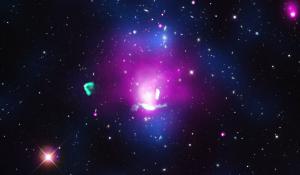Blog
Radio Phoenix
3 September 2015
 X-ray: NASA/CXC/Univ of Hamburg/F. de Gasperin et al; Optical: SDSS; Radio: NRAO/VLA
X-ray: NASA/CXC/Univ of Hamburg/F. de Gasperin et al; Optical: SDSS; Radio: NRAO/VLAA radio galaxy is a galaxy that emits large amounts of radio energy. They are powered by the supermassive black hole in their center, and thus can have active and dormant periods. During the active periods lobes of ionized material streams from the region near the black hole, and this energized material emits radio waves. During a dormant period this material doesn’t emit energy, but it’s still there in the region of the galaxy. As a result, which two galaxies collide this material can be re-energized by colliding with material from the other galaxy, radio energy is again emitted, creating a kind of “radio phoenix.”
The radio phoenix period of colliding galaxies doesn’t last long on the cosmic scale, so it can be difficult to observe in action. But new observations of a galaxy cluster known as Abell 1033 has found a region that is just beginning to re-energize.1 By observing the cluster at visible, x-ray, and radio wavelengths, the team found that lobes emitted earlier by a galaxy’s black hole has now undergone compression due to shock waves from collision with another galaxy. The compressed regions are the very regions where radio waves are being emitted. You can see this effect in the composite image. Blue represents the distribution of the lobe material, pink shows x-ray emissions indicating hot material, and cyan indicates the region of radio emissions.
This work gives us insight on the dynamics of galaxy collisions. It’s also a great demonstration of how combining observations from different regions of the electromagnetic spectrum allows us to determine far more than any single region could.
de Gasperin, F., et al. “Abell 1033: birth of a radio phoenix.” Monthly Notices of the Royal Astronomical Society 448.3 (2015): 2197-2209. ↩︎